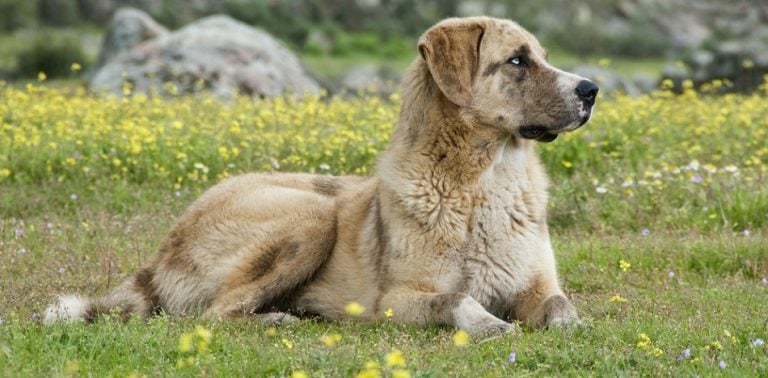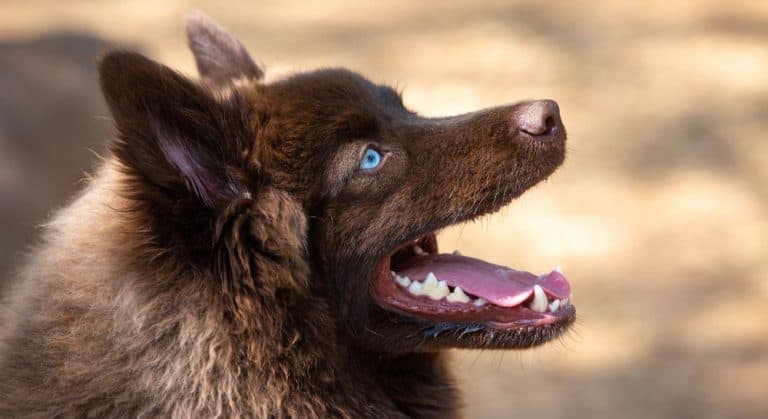Newfoundland Growth Chart – Weight & Size Chart
You fell in love. What’s not to love about a Newfoundland? They’re big, they’re cuddly, they’re smart, and they’re simply gorgeous. But raising a puppy this big is going to be a challenge.
Use our Newfoundland Growth Chart to see if you’re on track. You want what’s best for your dog, and bigger and heavier aren’t necessarily better.
In fact, with a dog that’s going to get this big, you want him to be on the lean side, or health problems will be an inevitable result.
Let’s go through the process of raising your Newfie to healthy adulthood together. Share more years with your companion with our guidelines to help you.
When Do Newfoundlands Stop Growing?

Before we kick off, let’s remind ourselves that Newfoundlands aren’t like other dogs. They grow, and they keep growing long after most other breeds have reached their adult height and weight.
So what’s the answer to that “when do Newfoundlands stop growing” question? Well, usually, a Newfie is fully grown at 2 years.
Here’s what you need to know: if your dog isn’t increasing in height after reaching adulthood, but is gaining weight, you need to make sure that the weight gain isn’t a result of being overweight.
Newfoundland Weight Chart
When should you worry about your Newfoundland’s weight? If he’s underweight, he could be undernourished or have health problems you need to know about.
But in young dogs, being overweight is much more of a concern. In our Newfoundland weight chart, we’ve used average weights.
We’ve set it up as a Newfoundland puppy growth chart so that you can follow his or her development from start to finish.
But the key lies in the word “average.” Your dog could be bigger or smaller than average and still be perfectly OK.
So, use this as a broad guideline and do ask the breeder whether the parents of your pup are larger or smaller than average for the breed. That might help as an indicator of what you ought to expect.
Weighing your dog at home is not going to be easy. He or she is simply too big for the usual methods.
Most veterinary clinics will let you bring your pet by for a free weigh-in, and some pet food specialist shops are also equipped with a doggie scale.
If weighing your pup regularly isn’t an easy matter for you, use observation. A dog should have a waist.
You should also be able to just feel the ribs under the skin. They shouldn’t protrude, but they also shouldn’t be so well-padded that you can barely feel them at all.
You can also measure your Newfoundland’s height at the shoulder. In adults, the average is 26 to 28 inches.
If your Newfie is bigger or smaller than that, the average weight can be higher or lower than what you see in our chart. When in doubt, get your vet’s opinion.
Newfoundland Puppy Weight Chart
| Age | Male Weight in lbs | Female Weight in lbs | Male Weight in kg | Female Weight in kg |
|---|---|---|---|---|
| 1 Month | 8 lbs - 12 lbs | 7 lbs - 11 lbs | 3.6 kg - 5.4 kg | 3.2 kg - 5 kg |
| 2 Months | 18 lbs - 27 lbs | 15 lbs - 22 lbs | 8.2 kg - 12.2 kg | 6.8 kg - 10 kg |
| 3 Months | 41 lbs - 54 lbs | 38 lbs - 46 lbs | 18.6 kg - 24.5 kg | 17.2 kg - 20.8 kg |
| 4 Months | 57 lbs - 65 lbs | 45 lbs - 56 lbs | 25.9 kg - 29.5 kg | 20.4 kg - 24.4 kg |
| 5 Months | 63 lbs - 75 lbs | 54 lbs - 67 lbs | 28.6 kg - 34 kg | 24.5 kg - 30.4 kg |
| 6 Months | 74 lbs - 87 lbs | 59 lbs - 71 lbs | 33.6 kg - 39.5 kg | 26.8 kg - 32.2 kg |
| 7 Months | 82 lbs - 97 lbs | 66 lbs - 75 lbs | 37.2 kg - 44 kg | 30 kg - 34 kg |
| 8 Months | 92 lbs -101 lbs | 69 lbs - 78 lbs | 41.7 kg - 45.8 kg | 31.3 kg - 35.4 kg |
| 9 Months | 102 lbs - 114 lbs | 75 lbs - 84 lbs | 46.3 kg - 51.7 kg | 34 kg - 38.1 kg |
| 10 Months | 109 lbs - 121 lbs | 83 lbs - 92 lbs | 48.4 kg - 54.9 kg | 37.6 kg - 41.7 kg |
| 11 Months | 112.5 lbs -127 lbs | 88 lbs -99 lbs | 51 kg - 57.6 kg | 40 kg - 43.9 kg |
| 12 Months | 114lbs - 130 lbs | 92 lbs - 106 lbs | 51.7 kg - 59 kg | 41.7 kg - 48.1 kg |
| 24 Months | 130 lbs - 150 lbs | 100 lbs - 120 lbs | 59 kg - 68 kg | 45.4 kg - 54.4 kg |
Newfoundland Growth Chart – What To Expect

Birth – 2 Weeks
At this time, there’s not a lot for you to do except taking good care of Mommy Newfie. Her health determines how well she can feed her pups and she will need extra food to keep her strength up.
As for the pups, they’re totally dependent on her, and with their eyes and ears closed, they’re not receiving input from the outside world yet.
If anything does go wrong with Mom dog, you urgently need help from a vet since you must bottle feed the youngsters at frequent intervals using a specialized puppy formula.
3 Weeks – 12 Weeks
Mom dog will know when to begin weaning her pups, but providing an alternative food source will make it easier for her to start the process.
She’ll start spending less time with her pups, who are now wide awake to the world around them. Leave some puppy formula with a little bit of solid food (high-quality puppy kibble is great) soaked into the mix out and watch what happens.
In the succeeding weeks, reduce the puppy formula and add more solids to the mix. By the 8-week mark, your puppies will be sufficiently weaned to home out, but it’s better to wait until the 10 to 12-week mark.
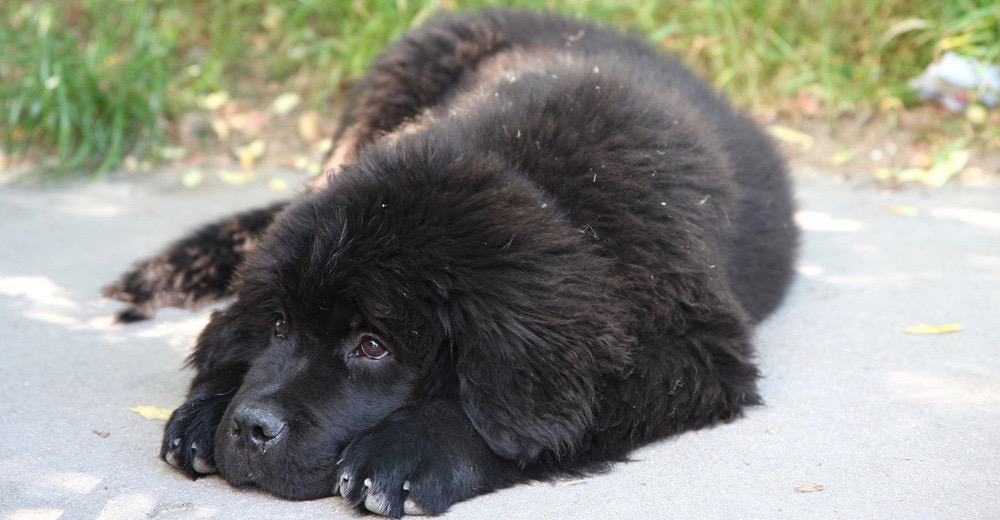
4 Months – 9 Months
By now, pups should be in their permanent homes and away from Mom. At this point, you’re basically taking over from her, and the puppy is very much a baby. Folks, this is a big dog and the puppies are enormous.
They weigh in at around 46 lbs on average at just 12 weeks and will gain size and weight fast! Use our Newfoundland puppy weight chart as a basic guideline to development.
By this time, they’re even bigger than that and they just keep growing! They’ll also be super-playful. Destructive? Quite possibly. Naughty? Not really. Newfoundland pups are sensitive and eager to please.
Training is a must, but never be harsh. Some gentle pointers are all that’s needed. New to puppy training? Get help at a local puppy school.
10 Months – 18 Months
By now, you already have an exuberant giant on your hands. But don’t be fooled! It’s still just a young ‘un. And it hasn’t stopped growing yet – not by a long shot!
The growth curve will be flattening out a bit, possibly to your relief, but your dog will still get even bigger. The really important thing to remember is that the “growth plates” in your puppy’s bones haven’t closed yet.
Sure, it’s a big pup, but you need to take care not to damage development by over-exercising your pup. That means no long walks, certainly not on hard surfaces.
Free play in your (hopefully) spacious yard is best, but a little gentle walking on the lead will help getting the young one accustomed to walking with you.
You will not be running. And you will be limiting the time of the walks to a maximum of 5 minutes per day per month of age. That daily walk shouldn’t happen all at once either.
Adult
The advice we’ve given about taking care of your pup’s skeletal structure is valid until he or she is about 24 months old.
Prior to that, it would be unwise to think of your pup as being an adult, even though the size might fool you into thinking your pup’s all grown up.
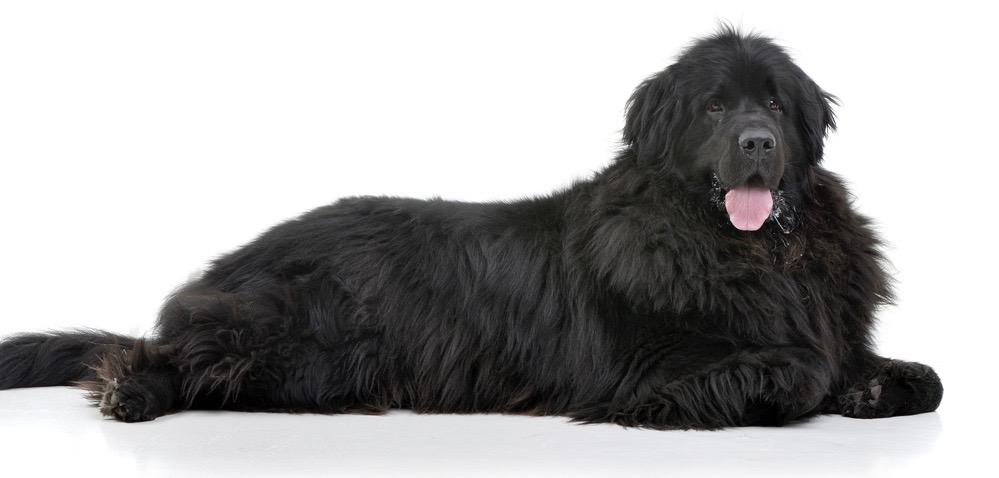
Gentle training should have been ongoing since your Newfoundland first arrived at your home, and since these dogs are highly intelligent and want to make you happy, they’re very receptive to it. Keep up the good work.
Being overweight is a huge health risk for giant breeds, so keep monitoring weight and try to find the sweet spot where your Newfie is “just right,” neither too fat nor too thin. That goal post will keep moving until your dog stops growing at 18 to 24 months.
How Big Do Newfoundlands Get?
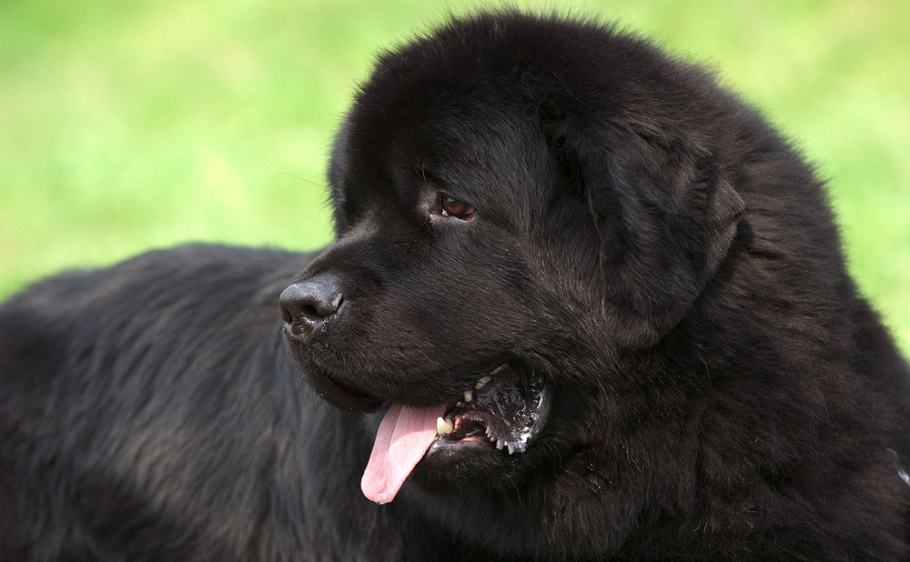
It is pretty likely that you already know how big a Newfoundland will get. They are large dogs.
If you are wondering how big your puppy will get, you can first look to a Newfoundland Growth Chart for guidance, but that isn’t your only source.
If you have seen the size of your puppy’s parents, it will give you the biggest clue to how big your dog will wind up.
You can also simply take a look at your dog’s paws and see how much growing your dog will need to do to fill them out. Another option is to try a DNA test if you aren’t sure about your dog’s lineage.
Newfoundland Size Chart
Looking at their height, the average height for a Newfoundland adult male is between 27 and 29 inches. The average adult height for a female is between 25 and 27 inches. As you can see, female Newfoundland dogs are slightly smaller than the male dogs.
To measure your dog’s height, you will want to have him standing up on all four legs. Then, using a tape measure, measure from the highest point on your dog’s back down to the floor.
That way, you can compare his height to the averages for his age.
Will Neutering/Spaying Affect My Newfoundland’s Growth?
Most puppy owners will automatically plan on having their dog spayed or neutered during the first year. If you are not planning on breeding a dog or using them for show, there is no reason to not have the surgery done.
Sterilization surgery is common, safe, and it will prevent unwanted pregnancies and complications. It will also prevent your dog from running off in search of a mate. But, there is a growth concern involved with the process that did not exist before.
In recent years, it has been shown that if large breed dogs, like a Newfoundland, have the surgery performed too young, their joints will not develop properly. It is best to wait until they stop growing.
How To Properly Weigh And Measure A Newfoundland Dog?
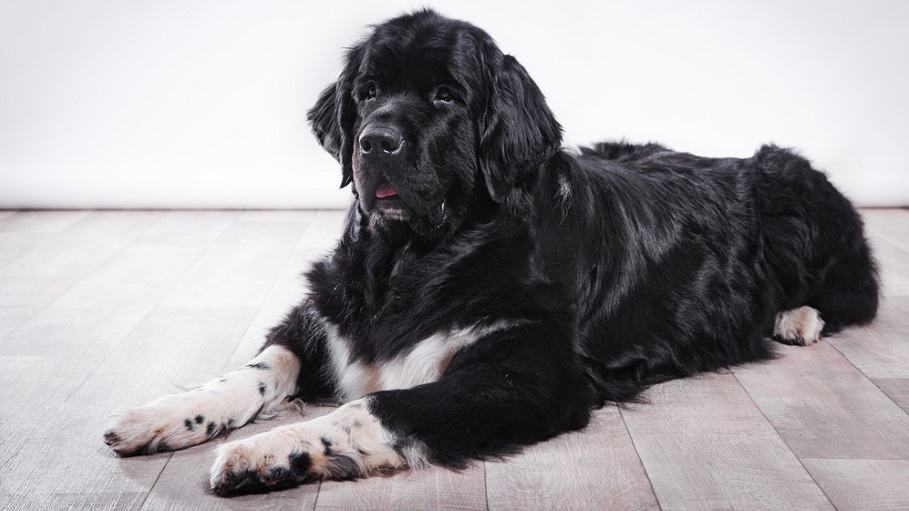
You might be looking at the weight or growth charts for a Newfoundland dog and wonder how you can even know what your dog’s measurements are. There are a few different things that you can try in order to get a good weight on your dog.
The easiest is when a Newfoundland is a small puppy. Then, you just need to use a scale at home. Weigh yourself first, then weigh yourself holding the puppy. The difference in the weights is your puppy’s size.
Naturally, Newfoundlands will soon get too big to weigh while holding them. If your dog has reached that point, you can either take him to the vet for a weight check or you can spend the $200 it costs to buy a large dog scale for your home.
St. Bernard vs Newfoundland Size
Even though their coloring is different, St. Bernards and Newfoundlands have a lot in common. They are both large, fluffy dogs with big, wide heads. A Newfoundland has a little bit more of a slender snout than a St. Bernard does.
Size-wise, a Newfoundland is very slightly smaller than a St. Bernard. Both are such large breeds, however, the difference is not notable. A St. Bernard will range from 120 to 180 pounds, while a Newfoundland is between 100 and 150 pounds on average.
In height, the St. Bernard is also very slightly larger. A St. Bernard stands between 26 and 30 inches, while a Newfoundland can stand between 25 and 29 inches.
What Is A Newfoundland’s Neck Size?
When you are thinking about growth, you might not be thinking about the size of your Newfoundland’s neck, but it does need to be considered.
We place collars around our dog’s neck, so if it does not fit well, the collar will not do its job. A collar that is too small can choke your dog, while a collar that is too large will just fall off.
An adult Newfoundland’s average neck size is between 26 and 32 inches. If you have a Newfoundland puppy, remember to buy a collar that is adjustable, because your pup will be growing steadily and easily outgrow his collar.
How To Help Your Newfoundland Lose Weight If He Is Overweight
If you have been told by your vet that your Newfoundland is overweight, you will need to take some steps in order to help your pup slim back down.
The first thing to do is follow whatever advice that your vet gives you. After that, we have some other ideas.
- Exercise your dog: It might seem obvious, but dogs really do need exercise that goes beyond their general running around. Take your dog on walks, hikes, play fetch, and you can even take your dog swimming.
- Review the food: What kind of dog food are you giving your pup? If you are feeding him food that is too full of fillers, you will not be helping your dog to lose the extra weight. Go with a high-protein, no-grain kind of food if you can.
- Cut out the treats: It is so tempting to give your dog treats all of the time, but they do not need them.
Newfoundland Body Shape Changes
There has been some concern about Newfoundlands being bred to be increasingly brachycephalic. That means “having a short head:” think Bulldogs and Rottweilers.
The Canine Research Institute points out that the Newfoundland’s historic shape indicates a much healthier dog than that which the American Kennel Club currently promotes.
That could mean that getting a Newfie who doesn’t reflect “best” breed standards in terms of head shape could be a good thing.
Regarding the rest of the body, growth, and development, you can certainly expect your pup to bulk out a bit in shape once it stops growing in height.
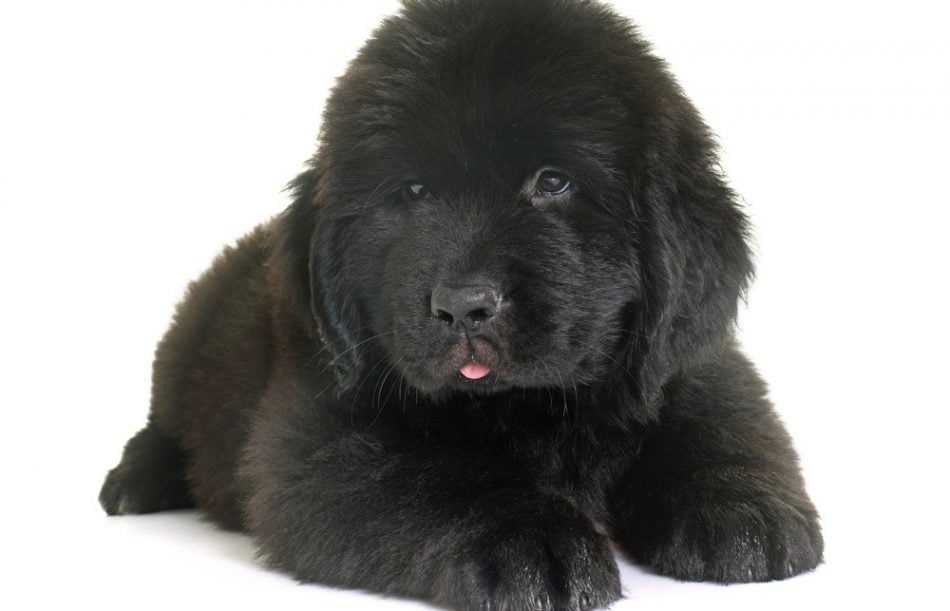
However, you should guard against too much bulk being put on. Newfies love to eat. Free feeding is definitely out, and measured meals twice daily should provide adequate nutrition without letting your dog get so heavy that he develops typical “big breed” complications.
Do consult a Newfoundland weight chart as an indication on whether you’re getting the balance right.
Factors That Affect Newfoundland Puppy Growth
Genetics
As we already pointed out, Newfoundlands are all big dogs, but some are bigger than others. It comes down to their genetic makeup.
You can get some indication of what to expect from your puppy’s genes by looking at the dam and the sire. If they’re both big specimens for the breed, there’s a fairly good chance your pup will be too.
But genes from grandparents also matter, so your pup might not match the profile of either parent. There are also some “late bloomer” Newfies that seem to start growing rapidly later than their siblings.
Nutrition
Genetic potential is just what it says. Genes may indicate how big your pet should get, but whether those genes express themselves to the full depends on several factors.
Nutrition is one of the most important of these. An undernourished puppy will not reach its full genetic potential. As an example, consider that fact that World War 2 rationing led to an entire generation of people who were shorter than their kids or grandchildren who didn’t face food shortages.
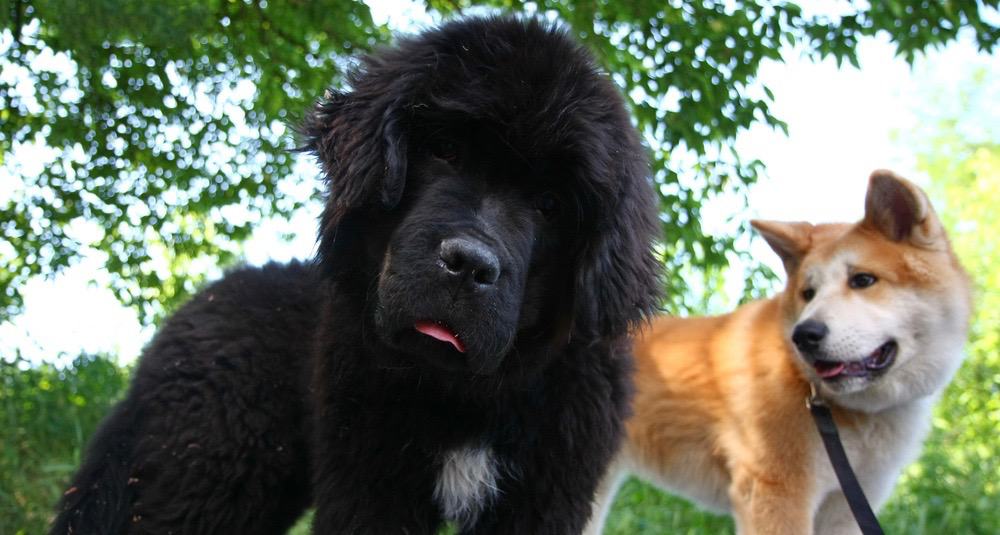
Dogs are no different. Without adequate nutrition, they won’t grow as big as they should. Puppyhood is a crucial time. Use our Newfoundland size chart as a starting point for getting the balance right.
Physical Activity & Health
Physical activity and health are also crucial to a puppy’s development. Ensure that your pup has lots of space to play, but don’t force it to undergo long or strenuous walks, even if you’re finding its energy a little too much for you to handle.
Try to keep your pup away from hard or slippery surfaces that may adversely affect bone and joint health later on. Games involving jumping during puppyhood are also not recommended. Watch your puppy’s health.
Poor appetite, listlessness, constipation, or diarrhea are not good signs. Healthy adulthood requires a healthy puppyhood. If you have any cause for concern, consult your veterinarian.
How Long Are Newfoundlands Pregnant?
With such big puppies, you’d expect Newfoundlands to be pregnant for longer than the average 63 days. But they reproduce as other dogs do – just on a grander scale.
If you’re the owner of a pregnant Newfoundland, do take her to the vet for a checkup – and remember that 63 days is, yet again, an average. The pups can surprise you with an early arrival – or they could take a few days longer than you expected to put in appearance.
As always, contact your veterinarian if you feel that there is any cause for concern. Although Newfies are not among the dog breeds most frequently needing a cesarean, they do sometimes require it.
How Many Puppies Do Newfoundlands Have?
If you’re looking for an easy answer to this question, there isn’t one! Newfoundlands give birth to anything from 4 to 12 puppies.
Since you will be taking Mom Newfie to the vet once you realize she is pregnant, you can ask for sonar to find out just how many bundles of joy she’s going to deliver.

Since a litter of 12 is hard for any dog to handle, you might have to be ready to pitch in with extra vigilance and help if she’s expecting a particularly big litter! Knowing how many pups to expect can be a big help, but regretfully, the answer isn’t to be found here.
What If My Newfoundland Is Not The Right Weight?
If your Newfoundland’s weight does not match the Newfoundland puppy growth chart or the Newfoundland weight chart for adult dogs, the first thing to do is to assess its condition.
With such a thick coat, the visual “can you just see the ribs without them actually protruding” guideline used for short-haired breeds won’t work for you. Go by feel instead. You can also get a fair idea of a dog’s condition by looking at its coat.
Heavier is not necessarily better, either. But a big Newfoundland will weigh more than average. Once again, you can try the feel test.
If you can’t feel the ribs through the skin, your dog may be overweight. To remain in good health for as long as possible, your Newfies should be on the lean side – but not skinny. Still not sure? You know who to ask! Time for your next visit to the local veterinarian!
What Is The Life Expectancy Of Newfoundlands?
It’s a sad truth that the larger dog breeds have a shorter life expectancy. Newfies are no exception to that rule. The average Newfoundland dog lifespan is between 8 to 10 years on average.
Once again, fate may intervene earlier, or you could be lucky enough to keep your gentle giant alive and well for longer than the average.
Whatever you do, don’t choose a Newfie just because you want a dog that won’t live too many years. It’s the wrong reason for choosing a pet, and if you thought a “shorter life span” is the same as “low maintenance,” think again!
How Much Does It Cost To Own A Newfoundland?
In short: a lot. We can start with the price of a puppy which, from a reputable breeder, will cost around $1.5K to $2K. And in case you were wondering, that breeder is lucky if they’re breaking even.
There are a lot of medical screenings that breed dogs should undergo, one should avoid allowing a bitch to breed as early as is physiologically possible, and the process of caring for a bitch with pups is cost-intensive too.
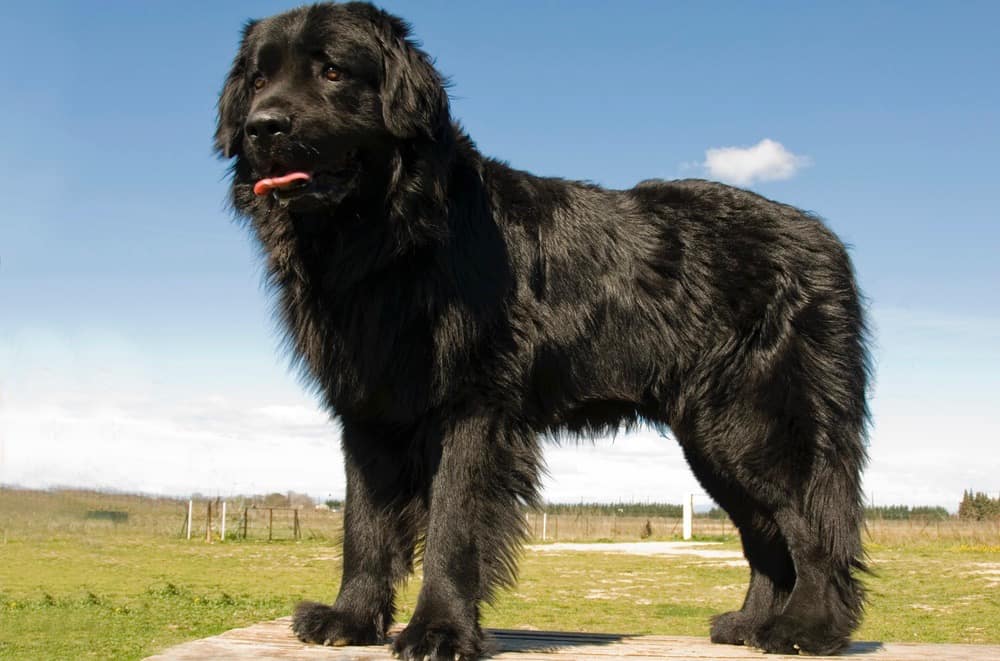
Once you’ve paid for your pup, you will still have a lot of financial obligations. Apart from feeding – and Newfoundlands eat a lot – there are vet bills, and they will only become costlier as your dog ages.
Giant dogs need giant budgets, and if you aren’t happy with that, choose a smaller, lower-maintenance breed.
Newfoundland Genetics And Common Health Problems
The very thing about Newfoundlands that attracts us most and has us hunting down a growth chart to help us watch these baby giants’ growth is also the breed’s greatest weakness: size.
As with other giant breeds, canine hip dysplasia (CHD) is a common problem which calls for care in choosing a breeder who actively screens sire and dam as well as the resulting pups for signs of susceptibility to this disorder.
Over and above that, your care can help to avert CHD issues as well as arthritis that commonly affects large breed dogs, often at a relatively young age.
Other health problems associated with Newfies are, once again similar to those of other giant breeds: these include gastric torsion and ligament ruptures.
Cataracts are relatively common though easily (if expensively) treatable. Epilepsy and heart problems are also associated with the breed. Ask your vet about hip, elbow, cardiac, and eye testing, and do choose a breeder who selects your pup’s parents from strong genetic lines.



